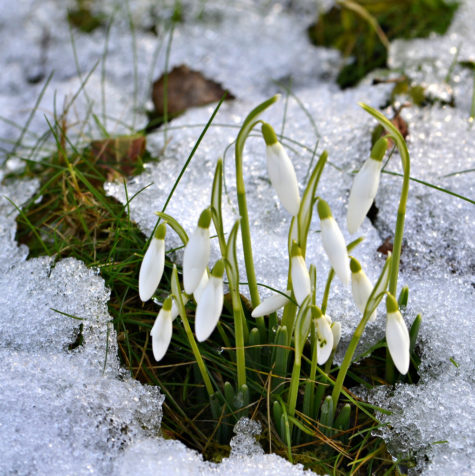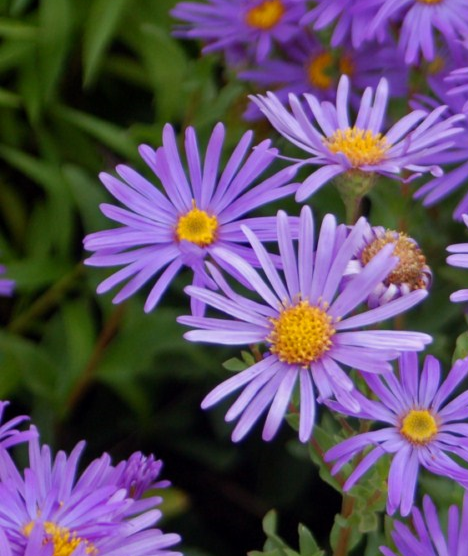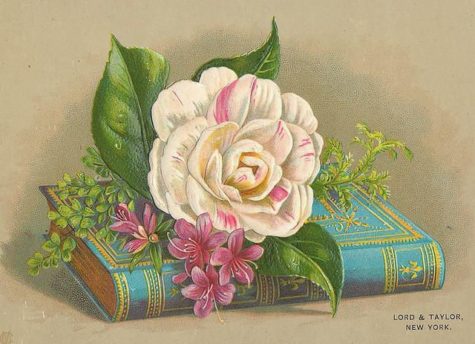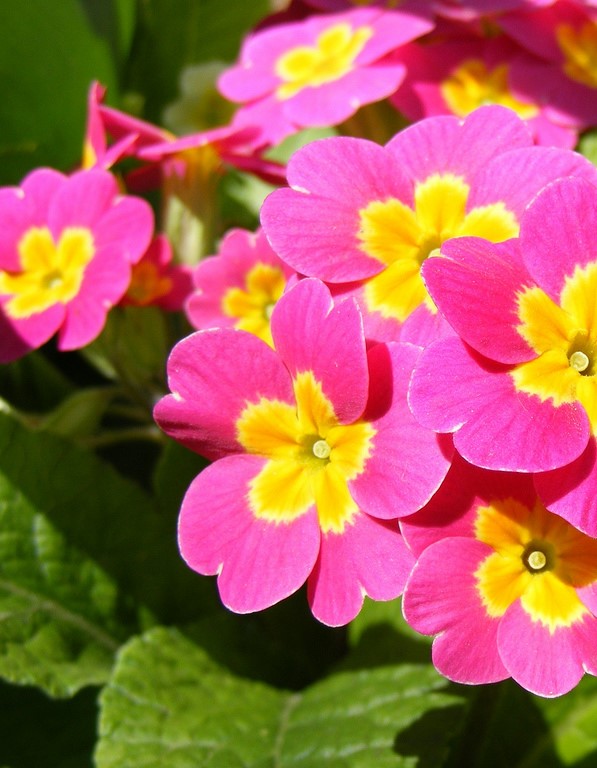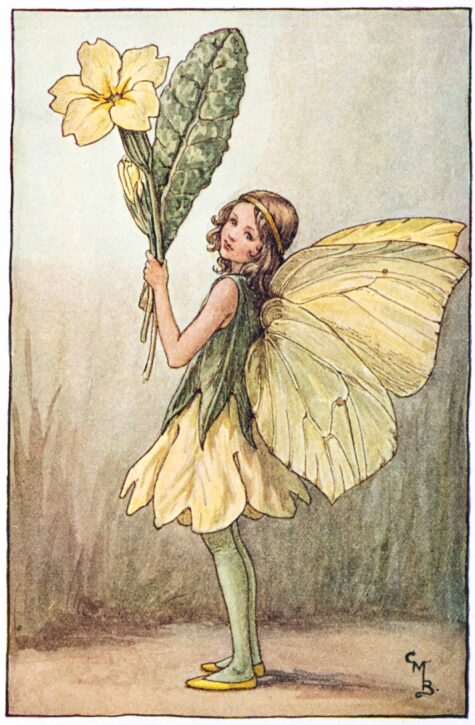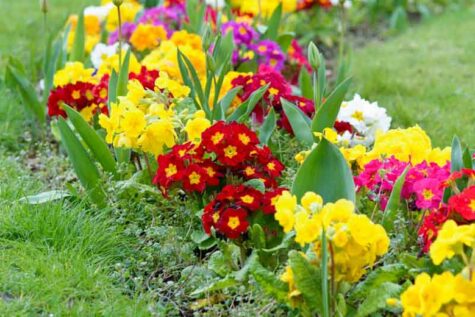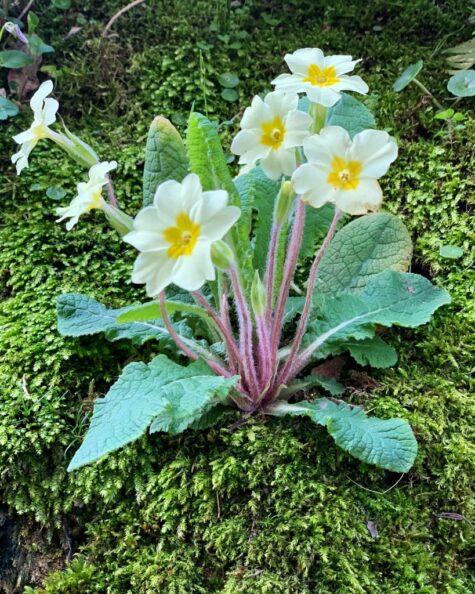Flowers
- Scientific Name: Galianthus nivalis
- Common Names: Fair Maid of February; Bulbous Violet; Emblem of Early Spring; Maids of February; Candlemas Bells; Mary’s Tapers; Moly
- Type: Flower
- Parts Commonly Used: The flower
- Basic Powers: Hope, Friendship in adversity, Passing of sorrow,
Snowdrops are often assigned to the month of January, and I’m not sure why because these little flowers are also known as “Candlemas Bells”. February 2nd is Candlemas (Festival Day of Candles), and Imbolc. The ancient festival marks the midpoint of winter and some recognize it as the last day of the forty day Christmas season. In the catholic tradition, candles were brought into the church and blessed as a symbol of hope and light. In a time of no electric lights, candlelight offered great protection and comfort during the dark days of winter.
By producing their own heat, snowdrops actually melt the snow in their surroundings. Like candles, Snowdrops offer us our own light of hope in the grey of winter days. They are the emblems of friendship in adversity, harbingers of spring.
The first sight of snowdrops growing wild represents the passing of sorrow. In various religions, they are a sign from the gods that good times will come once more. According to one Christian tale, an angel turned falling snowflakes into flowers to give Adam and Eve a sign of hope after evicting them from the Garden of Eden.
The fact that snowdrops are often found, in abundance, in the old convent gardens, it was believed that this little white flower was sacred to virgins. For this reason, it was dedicated to the Virgin Mary. In some places, during the Candlemas celebration, it was customary for young women, wearing white gowns, to walk in procession carrying snowdrops in their hands.
It was often said that any one wearing a snowdrop would have only pure and lofty thoughts; and that if a young girl ate the first snowdrop she found in spring, neither sun nor wind would tan her that summer.
The snowdrop flower – which is well loved not only for its simple beauty, but for its distinct, honey-like scent – has a surprisingly varied history in both ancient folklore and more modern storytelling. In Grimm brother’s original version of the fairy tale nowadays known as Snow White, the main character’s name was actually Snow Drop.
Every spring on March 1, the national Moldovan holiday, is celebrated. On this day people present each other with the traditional flowers. One of the old Moldovan legend says that once in a fight with the winter witch, that didn’t want to give up its place, the beautiful lady Spring cut her finger and few drops of her blood fell on the snow, which melted. Soon on this place grew a snowdrop and in such a way the spring won the winter.
However, in some folklore, snowdrops are seen as unlucky. The reason for this is perhaps that they often grow in cemeteries and churchyards. Along with other white flowers, superstition says it is courting disaster to bring snowdrops into the house. To do so is to invite death into the home, can mean the parting of a loved one and, in the west country, is thought to cause eggs to turn addled. One should never even pick wild snowdrops, especially from a graveyard. The sight of a single snowdrop blooming in the garden foretells of impending disaster.
According to Are You Superstitious, by Lore Cowan, it is particularly unlucky to bring snowdrops, or “Candlemas bells”, into the house on February 2nd, which is Candlemas, or Imbolc, and if you wish to be married within the year you should not bring them into the house on Valentine’s Day, 14th February.
Snowdrops have their use in medicine. The alkaloid Galantamine, which was first isolated from snowdrops, has been used to treat Alzheimer’s disease, neuritis and neuralgia. In parts of eastern Europe, rubbing snowdrops on the forehead was at one time a folk remedy used as pain relief.
Andreas Plaitakis and Roger Duvoisin in 1983 suggested that the mysterious magical herb moly that appears in Homer’s Odyssey is actually snowdrop. An active substance in snowdrop is called galantamine, which, as an acetylcholinesterase inhibitor, could have acted as an antidote to Circe’s poisons.
Note: This post was compiled by Shirley Twofeathers for Magical Ingredients, you may repost and share without karmic repercussions, but only if you give me credit and a link back to this website. Blessed be.
- Scientific Name: Asteraceae
- Folk Name: Michaelmas Daisies, Frost Flowers, Starworts
- Type: Flower
- Ruler: Venus
- Parts Commonly Used: Blossoms, Leaves (rarely)
- Basic Powers: Loving vibrations, Healthy emotions, Contentment, Protection
Also known as starworts, Michaelmas daisies or Frost flowers, the name aster is derived from the Greek word for “star,” This is largely due to the shape of the flower’s head; however, it is also because they grow in a spotted abundance and have an appearance similar to that of the stars in the sky.
With their wildflower beauty and lush texture, asters have long been considered an enchanted flower. The Greeks and Romans believed this flower was sacred to the gods and so wreaths of asters were placed on their altars.
In mythology, asters were said to have grown from the tears of the goddess Asterea. This ancient myth arises from the Iron Age, when people learned to make weapons of iron, the god Jupiter, was angered by all the fighting with these iron weapons that he decided to destroy the entire race by a flood. The gods fled the earth and the last to go, the goddess Astraea, was so saddened that she asked to be turned into a star. When the flood waters receded, all that was left was mud and slime. Astraea felt so sorry for them she wept, her tears falling as stardust which turned to lovely starflowers or asters. while she wept for the lack of stars on earth.
Roman mythological legend holds that one of the dryads presiding over the forest, meadows and pastures, the nymph Belides, was responsible for the origin of this flower. While dancing on the turf at the edge of the forest with the other nymphs, Belides attracted the admiration of the deity who presided over the orchards whose name was Vertumnus. She transformed herself into the flower bellis, it’s botanical name, to escape the pursuit of Vertumnus. The bellis flower is derived from the Anglo-Saxon “daeges eage” (day’s eye) from the habit of this flower to close its petals at night and on dark rainy days.
Another legend has it that the fields bloomed with asters when Virgo scattered stardust on the earth.
Asters are ancient wildflowers of the daisy family, and attract butterflies to your yard. There are over 600 species of aster, the most popular being the Monte Casino. These star-like flowers can be found in a rainbow of colors – white, red, pink, purple, lavender and blue, with mostly yellow centers.
Asters are sacred to Venus. Incorporate asters into spells and charms to enhance loving vibrations and healthy emotions. Adding these beautiful flowers to your garden brings love and contentment to your entire household.
Historically, aster flowers have had many uses. One of the best known is their use when placed upon the graves of French soldiers; these flowers were meant to symbolize afterthought, the wish that things had turned out differently, and to represent a desire for the reversal of the outcome of their battles. In China, they signify fidelity.
Known as “Eye of Christ” in France and “Starwort” in England and Germany, asters were thought to carry magical powers. The early English name, Starwort, was later changed to Michaelmas Daisy, as it blooms around St. Michaelmas Day in September.
In ancient Greece, aster leaves were burned, as it was thought that the smokey perfume would keep ward off wicked spirits and drive away serpents.
Asters may also be used for their strong medicinal properties. Some varieties of this flower are said to help with migraines, general headaches and colds, while others can aid in treating the pain of sciatica and muscle spasms. Virgil wrote that the flavor of honey would be improved if asters were boiled in wine and placed near a beehive.
In addition to having a wide array of colors to choose from, the aster flower also has a good deal of meaning to go alongside its good looks. In general, the aster is considered a symbol of patience, daintiness, and a love of variety. Others state that this flower is an emblem for refinement and elegance.
As a gift, asters placed in a bouquet with complementing flowers can be representative of love and admiration. They are often given to those born in September, or those celebrating a 20th wedding anniversary. As a more unique gift, you might present a single fresh or dried flower to a lover or friend as a love charm, as asters were thought by some ancient Greeks to hold the mystic power of drawing forth affection.
Found at: Flower Info and Meanings and Legends of Flowers
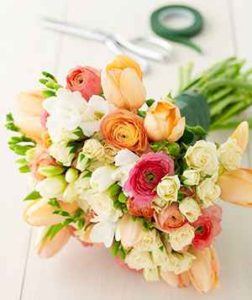 Flowers may be combined and arranged so as to express even the subtlest shades of sentiment. Here are some examples of how to use the language of flowers to send a message:
Flowers may be combined and arranged so as to express even the subtlest shades of sentiment. Here are some examples of how to use the language of flowers to send a message:
- Moss Rosebud and Myrtle – A confession of love
- Mignonette and Coloured Daisy – Your qualities surpass your charms of beauty
- Lily of the Valley and Ferns – Your unconscious sweetness has fascinated me
- Yellow Rose, Broken Straw and Ivy – Your jealousy has broken our friendship
- Scarlet Geranium, Passion Flower, Purple Hyacinth, and Arbor Vitae – I trust you will find consolation, through faith, in your sorrow; be assured of my unchanging friendship.
- Columbine, Day Lily, Broken Straw, Witch Hazel and Coloured Daisy – Your folly and flirtatiousness have broken the spell of your beauty.
- White Pink, Canary Grass and Laurel – Your talent and perseverance will win you glory.
- Golden-rod, Monkshead, Sweet Pea, and Forget-me-not – Be cautious; danger is near; I depart soon; forget me not.
The language of flowers, sometimes called florigraphy, was a Victorian-era means of communication in which various flowers and floral arrangements were used to send coded messages, allowing individuals to express feelings which otherwise could not be spoken. This language was most commonly communicated through Tussie-Mussies, an art which has a following today.
The nuances of the language are now mostly forgotten, but red roses still imply passionate, romantic love and pink roses a lesser affection; white roses suggest virtue and chastity and yellow roses still stand for friendship or devotion. Also commonly known meanings are sunflowers, which can indicate either haughtiness or respect – they were the favorite flower of St. Julie Billiart for this reason. Gerbera (daisy) means innocence or purity. The iris, being named for the messenger of the gods in Greek mythology, still represents the sending of a message. A pansy signifies thought, a daffodil regard, and a strand of ivy fidelity.
You might also enjoy the Dictionary of the Language of Flowers, a list organized by the flower meanings rather than the flower names. If you are interested in combinations of flowers, you might want to read this post on Combining Flowers for Specific Intentions.
These language correspondences can be used when creating a spell, planting a magickal garden, to set an intention, or to send a message. You may notice some of the flowers (and plants) have meanings that seem incongruent or inconsistent. This is because language tends to change over time. Also, you may find that magickal correspondences to some of these flowers are in direct conflict – that is because the meanings were not derived from magickal sources. When in doubt, go with the meaning that resonates with your personal experience, and be clear with your intention. Pictures may be substituted for the actual flower or plant.
Here’s the list:
A
- Acacia – Secret love
- Acanthus – Art
- Aconite – Misanthropy
- Acorn – Nordic Symbol of Life and immortality
- African Marigold – Vulgar minds.
- Agrimony – Thankfulness
- Allspice – Compassion
- Aloe – Grief
- Almond (Common) – Stupidity. Indiscretion.
- Almond (Flowering) Hope – Promise, Hope,
- Almond (Tree) – Giddiness; heedlessness Stupidity, thoughtlessness
- Alyssum (Sweet) – Worth beyond beauty.
- Amaranth (Globe) – Immortal love
- Amaryllis – Pride; Pastoral Poetry
- Ambrosia – Your Love is Reciprocated
- Anemone – Forsaken, sickness, unfading love
- Apple Blossom – Preference, Fame speaks him great and good.
- Apple (Thorn) – Deceitful charms.
- Apricot Flower – Doubt, distrust
- Arborvitae – Everlasting friendship
- Arbutus – You’re the only one I love
- Arum – Ardor
- Asparagus – Fascination
- Aspen Tree – Sighing, Lamentation
- Asphodel – My regrets follow you to the grave
- Aster – Symbol of love, daintiness, talisman of love
- Aster (China) – Fidelity, variety, I will think of you
- Autumn Leaves – Melancholy
- Azalea – Take Care, temperance, fragile, passion, Chinese symbols of womanhood
- Scientific Name: Primula vulgaris, Primula veris
- Common Name: Primrose, Cowslip, Key Flower, Herb Peter
- Ruler: Freya
- Planet: Venus
- Element: Earth
- Magickal Properties: Fairies, Protection, Love
Often associated with the month of February, the Primrose flower symbolizes patience, kindness and gentleness. The Primrose also brings the meaning of belonging, and nurturing. Primrose is used magically as a symbol to meditate upon to draw protection and love, Oil of primrose has been used to cleanse and purify in the Druidic tradition. This wildflower is also used to symbolize the beloved guest.
Primroses attract fairies to the garden.
- To invite the fairy folk to visit and to get fairy blessings hang a spray of primroses on your door.
- Eating primroses is said to help you see fairies.
- In Ireland and Wales primroses were thought to be fairy flowers that could give the power of invisibility.
- Celtic lore says rubbing primrose flowers over your eyelids can give you a way into the fairy world.
If you grow primroses in your garden, take very good care of them. Unhealthy primroses upset the fairies and it is not recommended to have cross fairies. If kept indoors, Primroses are said to bring sickness and sorrow, perhaps this is because they generally do not grow well indoors and upset the fairies.
On May Day, a string of primroses was used to decorate doors and thresholds. It was believed that fairies couldn’t pass over or under the string of flowers. When milking cows, primroses rubbed on the udder was thought to increase production and protect butter from being stolen by the little folk.
The pendant flowers of the cowslip, Primula veris, were sometimes called “Key Flower” in England because they were thought to resemble a hanging bunch of keys. The association with keys may also have led to another common name, “Herb Peter,” because the symbol of St. Peter is a bunch of keys. Ancient Norse peoples celebrated this primrose as a symbol of the goddess Freya, known as the “Key Virgin.”
In England, April 19th is known as “Primrose Day” in honor of Prime Minister Benjamin Disraeli, who loved the flowers. Every year, visitors to Westminster Abbey lay primroses on his statue. Primroses are the County Flower of Devon, where they grow profusely.
According to the “language of flowers” Primroses symbolize youth or young love, or mean “I can’t live without you.” Lilac-tinted primroses signify confidence and red primroses symbolize unappreciated merit. In the Chakra System, it is believed that the Primrose combines the solar plexus and heart chakras.
The flowers of some primroses, especially Primula vulgaris, are edible. They can be eaten raw in salads or as an edible garnish, and can also be made into conserves (preserves). P. vulgaris flowers can be combined with yeast and sugar and fermented into wine.
In their native Europe, primroses have long been prized for their medicinal and culinary uses. Traditional folk medicine utilizes the primrose to treat a number of ailments, such as:
- headaches
- wounds
- cramps
- spasms
- paralysis
- rheumatic complaints
In traditional herbal medicine, cowslip wine, made from P. veris, was used as a sedative. When the flowers were boiled with sugar to make a syrup, the concoction was used to treat palsy as well as nervousness. The juice of the flowers, either used alone or combined with other ingredients into an ointment, was supposed to be effective at treating facial spots and wrinkles.
An old gypsy cure for skin complaints on the face: take three primrose leaves and boil them in a pint of water, drink the water.
Scientific research indicates that primroses contain saponins and salicylates, which many have expectorant and anti-inflammatory effects. The roots and flowers have also been used as emetics, sedatives, antispasmodics, and astringents.
Though primroses are toxic to dogs, cats, and horses — and may cause vomiting if ingested — primroses are edible for humans. Leaves and flowers may be eaten raw or cooked, used as a herb, or as a garnish. The flowers can be used to make wine and syrup.
Primroses are mainly pollinated by bees but attract other long-tongued pollinators such as hoverflies, brimstone, and small tortoiseshell butterflies.
Collected from various sources including Garden Guides
 Scientific Name: Cosmos bipinnatus
Scientific Name: Cosmos bipinnatus
Folk or Common Names: Mexican Aster
Type: Flower
Ruler: Jupiter
Element: Air
Month: October
Numbers: 2 and 8
Parts Commonly Used: The flowers
Magickal Qualities: Harmony; Order; Balance; Simplicity; Confidence
The name Cosmos comes from the Greek kosmos, meaning order, harmony, or the world. The cosmos flower was said to have been named by Spanish mission priests in Mexico who grew them in their mission gardens. The priests felt that because of their symmetrically aligned petals these flowers should be named after the Greek word for “ordered universe.” However, when one closely observes the plant, it not only expresses order and harmony in the blossom’s symmetry, grace, and simplicity, but also in the symmetrically balanced, regularly-doubled production of leaf and blossom stems.
The “cup” of the Cosmos in full bloom is exactly the shape of a dish antenna, and is even “aimed,” at the sky at much the same angle as these wave receivers. The fully-open Cosmos blossom often turns this “dish antenna” somewhat towards the sun. When the wind blows, the blossoms turn their undersides to the direction of the wind so that the inner, fertile disc is sheltered behind a round “parasol” of ray florets.
The gestural shape of the blossom, a broadly opened cup turned towards the sun and the heavens indicates a character of openness and receptivity to messages from outside of the earthly realm.
Because the name Cosmos comes from the Greek word for harmony and order, and the cosmos flower is generally thought to be the symbol of order, harmony, peace and modesty.
- A gift of cosmos flowers will bring good luck.
- When given as a gift to a romantic partner, these flowers are commonly meant to represent the notion of walking together hand in hand, or to express the joys that love and life can bring.
- Plant them in your garden to attract fairies.
- Spend time in meditation with the flowering plants in the garden, and to attune your mind to messages from beyond.
It is said that Cosmos flowers will attract fairies, particularly if grown in a “wild” or uncultivated corner of the garden. This is also the environment where Cosmos is most at home, roadsides and waste places being the natural habitat of this freedom loving flower. It is interesting to reflect that “roadsides and waste places” are recognized in traditional cultures worldwide, as sites for spiritual epiphanies, encounters with spiritual beings in disguise, vision quests, walkabouts, and other metaphysical and transformative experiences of the . . . Cosmos.
The Cosmos has a form and gesture that is graceful, airy, and mobile. It is responsive to every breath of wind or touch by another living thing. It opens outwards in a generous gesture, expanding, trusting, and risking.
At the same time, it is protective of its innermost, female reproductive parts until they are fully ripe and ready to be released. It has an expansive signature in its bounty of blossoms and multitude of seeds that emerge from each blossom.
The blossom’s color signature shows a yellow center, symbolizing a strong solar plexus chakra, with a radiating aura of mauve or magenta, which seems to symbolize the sacralizing of the will by spiritual awareness. This suggests aid to those who feel afraid to assert their will in the world, because they are never quite sure whether their motives are informed enough by the highest possible consciousness.
Along with their harmonious symbolism, cosmos are also representative of October births and 2nd wedding anniversaries, and are frequently given as simple tokens of affection on these particular events. In 1999 the World Kindness Movement in Tokyo adopted the cosmos bipinnatus as the emblem for the organization.
Medicinal and Herbal Uses:
Some botanical sources state that cosmos has “no known uses” (or hazards) as food or medicine, others catagorize it as a weed. It seems extremely benign. Being both highly attractive to insects, and not causing any kind of allergies or skin irritation in humans, it is clearly lacking in irritants. Similarly, being scentless, it seems to lack any significant volatiles.
Compiled from various sources including Flower Info and The Flower Society
